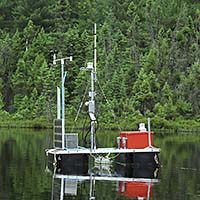Dances with Dragonflies: Agile Insect a Signal of Shoreline Health
(with Wireless Remote)
The modern world seems to melt away after a few days at Trout Lake Station—the surrounding North Woods slowly close in, creating a bubble of natural beauty.
But unbeknownst to many, several lakes in the area are increasingly entwined with the high-tech digital age.

An automated buoy at Crystal Bog uses wireless technology to transmit real-time data.
UW-Madison researchers are for the first time blending limnological questions with advanced wireless technology. It’s a marriage that will deliver real-time data to scientists, while connecting the remote lakes of the North Woods to a streaming network of data originating from lakes around the world.
With automated buoys — or “observatories” — deployed into seven North Woods lakes so far, UW-Madison researchers can now track dynamic features such as oxygen levels and thermal patterns with the mere click of a button. In the near future, scientists hope, a single Web site will seamlessly stream and compile data from countries as far away as Taiwan and Finland.
“Deploying ecological observatories into lakes worldwide will allow us to assess the rate and direction of ecological change,” says Tim Kratz, the director of the Trout Lake Station and leader of the global lake observatory effort. “For the first time the technology allows us to ask questions at a global scale, while keeping all the local details.”
The project is in fund raising stages and has solicited the participation of limnologists and wireless technology experts worldwide. If all goes well, Kratz says, the network will start to coalesce sometime next year.
Already though, the initiative is bearing fruit. New comparative projects are starting to emerge in Taiwan, for example, where wireless lake observatories have already been deployed in some lakes. At least one UW-Madison student is already there, exploring how lakes change when Taiwanese typhoons churn through them.